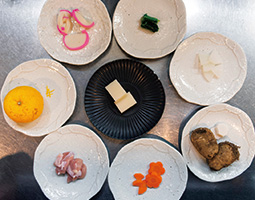Home > Highlighting JAPAN > Highlighting Japan January 2018 > Washoku
Highlighting JAPAN


O-zoni: An Unpretentious Delicacy
Introducing Japan’s soup of the New Year.
O-zoni — it’s no-frills cuisine at its finest.
Chicken, steamed naganegi leeks, carrots, sato-imo (taro) and other vegetables are cooked in a scented broth, then poured into a lacquerware bowl and topped with grilled mochi rice cakes, komatsuna (mustard spinach) and a sprinkling of peel from the yuzu citrus fruit.
And that’s it.
O-zoni, served today with some burdock and turnip pickles by Shigeaki Yoshie, owner and chef at Onigiri Cafe Risaku in Tokyo, is one of Japan’s most unpretentiously delectable dishes. It’s also one of Japan’s oldest and most symbolic.
O-zoni is known as a healthy repast, but for most Japanese it’s a once-a-year delicacy that’s served over the New Year holidays.
Invariably it’s enjoyed alongside o-sechi ryori cuisine, a colorful array of painstakingly prepared dishes made over several days from preserved ingredients that are placed in stacked lacquer boxes called jubako.
Traditionally the idea is that they will last throughout the holiday period and thus give those charged with meal preparation a well-deserved break from incessant cooking and washing.
“For Japanese the words ‘o-zoni’ and ‘o-sechi’ are inextricably linked with New Year,” says Yoshie, as he grills the “Uonuma Kogane” mochi, a prized rice cake variety from Niigata Prefecture, which bubbles and pops over the open flame like self-activating chewing gum. “When it comes to o-zoni, each region has its own variations, but the essence and meaning are universal.”
The origins of o-zoni are uncertain, with some theories suggesting it has its roots in so-called yusoku-ryori, a Kyoto court cuisine enjoyed by nobility in the Heian period (794–1185).
Another theory suggests it was concocted from the foodstuffs that for at least as long have been offered at Buddhist altars on certain festival days during the year, including New Year.
Traditionally these foodstuffs would comprise produce that could be harvested locally, according to Yoshie.
It is thought that this naturally led to the kinds of regional variations that are still in evidence today. The most notable differences can be found in the shape of the mochi and the types of soup used in Kanto, a region centered around Tokyo, and Kansai, which includes Osaka and Japan’s ancient capital, Kyoto.
While the former variety employs a soy sauce base and rectangular rice cakes, the latter uses white miso paste for the soup and an oval mochi varietal.
According to Yoshie, a possible explanation for the different mochi shapes is that traditionally the rice cakes have been molded in a round shape by hand and then placed on the altar along with other oval-shaped offerings, such as mikan oranges. The flat, rectangular kiri-mochi (literally, cut mochi) meanwhile are easier to mass produce, explaining their popularity in the densely populated Kanto region, Yoshie adds.
The other ingredients, meanwhile, are more closely connected with a timeless observation of the seasons and immediate living environment.
“Each region’s o-zoni has its own characteristics that reflect Japanese people’s longstanding ability to make use of local produce,” says Yoshie. “For example, in coastal communities, where chicken is less readily available, they use fish such as sea bream.”
The o-zoni variety found at Risaku, which includes o-zoni on its yearend menu by popular demand, is a kind of hybrid, reflecting the melting pot of regional cultures that can be found in the capital.
The soup is made from bonito and kelp broth to which Japanese sake, soy sauce, salt and mirin — a type of sweet sake used in cooking — is added. Like the mochi rice cakes, the chicken is carefully selected, with Yoshie ordering a succulent free-range variety known as “Daisen jidori” directly from a supplier in Tottori Prefecture.
Another commonly used ingredient is a variety of kamaboko (steamed fish paste) called “aka (red) kamaboko,” which usually comes in semi-cylindrical, gelatinized rolls with a “red” (actually pink) outer layer — pink, and red, being auspicious colors in Japan, particularly at New Year.
According to Yoshie, rather like Christmas dinners in the West, some of the components of o-sechi ryori are an acquired taste.
“O-zoni, however, is known as a dish that suits all tastes,” he says. “It is a simple, but sumptuous taste of New Year.”
© 2009 Cabinet Office, Government of Japan









